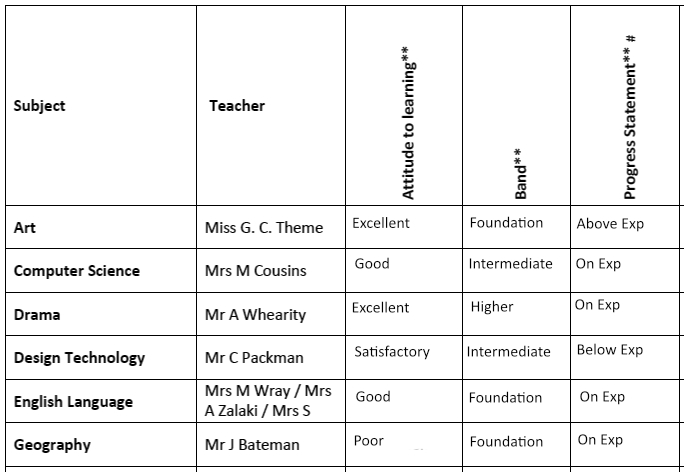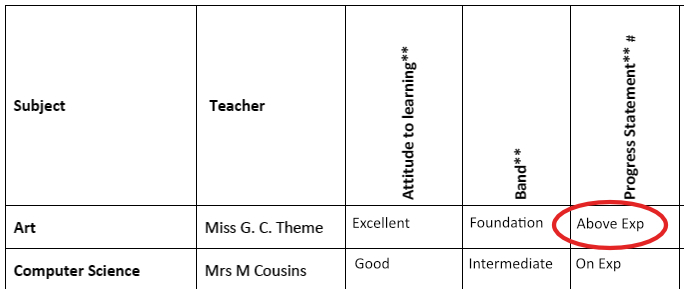- Home
- Parents & Carers
- KS3 Reports
KS3 Reports
How to read your Child's School Report
KS3 - years 7, 8 and 9
For our Key Stage 3 students, we choose a reporting approach which bands students according to their current ability which allows them to understand their targets and progress more easily.

The 3 Bands
At the beginning of year 7 we use a variety of internal and external data including SATs, CATs and subject-based assessments to allocate the initial banding for your child in each subject. The majority of students will be experiencing some subjects for the first time, so we would expect them to start at a lower base. Of course, every child is given the opportunity to move up (and down) bands throughout their school life
- Foundation
This indicates your child has a basic ability in the subject area. - Intermediate
This indicates your child has a sound ability in the subject area. - Higher
This indicates your child has an exceptional ability in the subject area.
KS3 is not assessed in the same way as KS4, but if you were looking for a comparison for the bands to GCSE grades, then the following gives you a indicative guide:
| Band | Current GCSE Grading | Equivalent GCSE Grade |
|---|---|---|
| Foundation | 1, 2, 3 | F, E, D |
| Intermediate | 4, 5, 6 | -C, C, B |
| Higher | 7, 8, 9 | A, A*, A** |
Each term, your child’s teachers will determine, through assessments and classwork, whether your child is working:
- within the parameters of the given band = On Expected
- above the parameters of the band = Above Expected
- below the parameters of the band = Below Expected
For example, if your child’s report at the end of the summer term says they are in Foundation band for Art, but working at Above Expected, you can expect them to move to the Intermediate band in the Autumn term in September.

How Bands Differ from Sets
The majority of our classes in school are taught in mixed ability groups with students of varying aptitudes in the same class, working together. This means Students who are working at Foundation, Intermediate and Higher levels are all being taught the same curriculum, at the same time. The philosophy is to teach to the top with scaffolded tasks to support those who have difficulty accessing the learning, and other tasks to stretch and challenge those working at a higher level.
Reading Age
KS3 reports also include your child's actual age compared to their assessed reading age. Students are tested once a term and reading ages are calculated using Renaissance Star Reading, which is a computer-adaptive baseline assessment that measures students' understanding and analysis of an author's use of language and literary devices to create certain effects. Each test takes about 20 minutes to complete.
How can I help improve my child's reading age?
Students should be reading for one hour a week, ideally for twenty five minutes every day. Their progress is supported by Bedrock Learning programme, which allows teachers to monitor the reading development and practices of their pupils and provides tools to quickly ascertain their reading level, reading age and comprehension level.
Banding Criteria
Each department are in the process of adding their branding descriptors to the website. We will add the links here, as and when they are published. In the meantime, if you have any questions, please contact our Heads of Department.
- Art - Mr Davis
- -- Art Criteria
- Computing - Mr Uwadiae
- Design Technology - Mrs Trenwith
- Drama - Mrs Whitmarsh
- English - Miss Webb
- Geography - Mr Tomala
- History - Mr Allger
- Maths - Mr Hussain
- French/Spanish - Miss Hudson
- Music - Mr Wicks
- PE - Mr Hird
- -- PE Criteria
- RS - Miss O'Reilly
- Science - Mr Burrows

